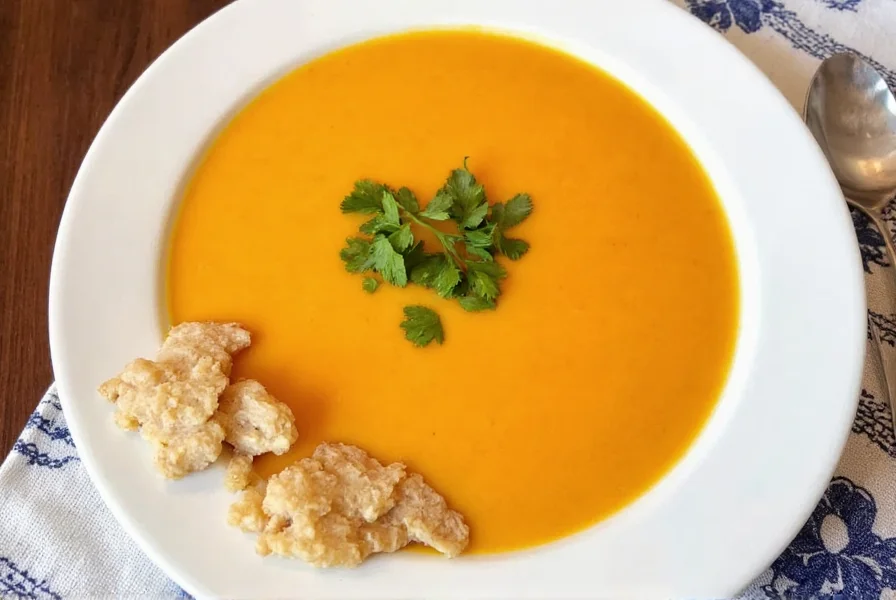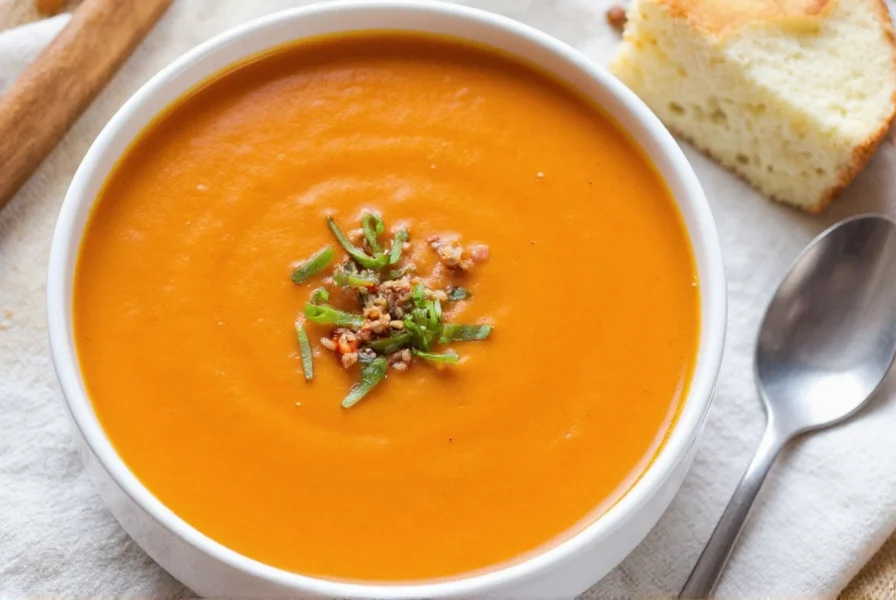For home cooks seeking a nourishing meal that's both simple to prepare and packed with health benefits, carrot and ginger soup stands as an exceptional choice. This vibrant orange soup has gained popularity across culinary traditions for its delightful flavor profile and impressive nutritional profile. Unlike many trendy recipes that promise health benefits without scientific backing, the combination of carrots and ginger delivers measurable advantages supported by nutritional research.
The Science-Backed Health Benefits
Understanding why carrot and ginger soup deserves regular rotation in your meal plan requires examining the powerful properties of its core ingredients. Carrots provide one of nature's richest sources of beta-carotene, which your body converts to vitamin A—essential for maintaining healthy vision, skin, and immune function. Just one cup of cooked carrots delivers more than 400% of your daily vitamin A requirement.
Ginger, meanwhile, contains gingerol—the bioactive compound responsible for its distinctive flavor and impressive medicinal properties. Studies published in the Journal of Medicinal Food confirm ginger's effectiveness in reducing inflammation, easing digestive discomfort, and potentially lowering blood sugar levels. When combined in soup form, these ingredients create a synergistic effect that enhances nutrient absorption while providing comforting warmth.
| Key Nutrient | Per Serving (1 cup) | Health Benefit |
|---|---|---|
| Vitamin A | 18,000 IU (360% DV) | Supports immune function and eye health |
| Vitamin C | 12 mg (20% DV) | Boosts collagen production and immunity |
| Gingerol | 15-20 mg | Reduces inflammation and nausea |
| Dietary Fiber | 4 g | Promotes digestive health and satiety |
Essential Ingredients and Quality Considerations
Creating an exceptional carrot and ginger soup starts with selecting quality ingredients. While this recipe remains forgiving for beginners, attention to ingredient quality significantly impacts the final result. For the most vibrant flavor and nutritional benefits, choose organic carrots when possible—they typically contain higher concentrations of beneficial carotenoids.
The ginger selection proves equally crucial. Fresh ginger root should feel firm and heavy for its size, with smooth skin and minimal wrinkles. Avoid pieces with soft spots or visible mold. When preparing ginger for soup, always peel thoroughly—unpeeled ginger can impart a slightly bitter taste that overwhelms the delicate carrot flavor. For those seeking an easy carrot ginger soup recipe with maximum health benefits, use freshly grated ginger rather than powdered, as the fresh form contains higher concentrations of active compounds.
Step-by-Step Preparation Guide
Follow this detailed method for creating perfectly balanced carrot and ginger soup that showcases both ingredients without either dominating:
- Prepare 1.5 pounds of carrots by peeling and chopping into uniform 1-inch pieces for even cooking
- Peel and mince 2-3 tablespoons of fresh ginger (adjust to taste preference)
- Sauté 1 diced onion in 2 tablespoons of olive oil over medium heat until translucent
- Add carrots, ginger, 3 minced garlic cloves, and 1 teaspoon of ground cumin to the pot
- Cook for 5 minutes, stirring occasionally, to develop flavor foundations
- Pour in 4 cups of low-sodium vegetable broth and bring to a gentle boil
- Reduce heat, cover, and simmer for 25-30 minutes until carrots are fork-tender
- Carefully blend until smooth using an immersion blender or standard blender
- Stir in 1/4 cup of coconut milk for creaminess (optional but recommended)
- Season with sea salt and freshly squeezed lemon juice to brighten flavors
Pro Tips for Perfect Carrot Ginger Soup Every Time
Professional chefs employ several techniques to elevate this simple soup from good to extraordinary. First, consider roasting the carrots before adding to the soup—this caramelization process enhances their natural sweetness and creates more complex flavor notes. Simply toss chopped carrots with olive oil, spread on a baking sheet, and roast at 400°F for 20-25 minutes before proceeding with the recipe.
For those wondering how to make creamy carrot ginger soup without dairy, coconut milk provides an excellent alternative that complements the ginger's tropical notes. Add it after blending for the creamiest texture. If you prefer a thinner consistency, gradually add additional broth until reaching your desired thickness.
Achieving the perfect ginger-carrot balance requires attention to detail. Start with the lower end of the ginger measurement (2 tablespoons), then taste after blending and adjust as needed. Remember that ginger's heat intensifies slightly as the soup sits, so it's better to under-season initially. For those seeking a spicier carrot ginger soup for immune support, add a pinch of cayenne pepper or a few slices of fresh red chili during cooking.
Serving Suggestions and Storage Tips
This versatile soup pairs beautifully with crusty whole-grain bread or a simple green salad for a complete meal. For an elegant presentation, top with a swirl of coconut milk, fresh cilantro, and a sprinkle of toasted pumpkin seeds. The soup's vibrant orange color makes it visually appealing, especially when served in white or earth-toned bowls.
Proper storage ensures your homemade carrot and ginger soup maintains quality. Cool completely before transferring to airtight containers. It will keep refrigerated for 4-5 days or frozen for up to 3 months. When reheating, add a splash of broth or water as the soup may thicken during storage. For meal preppers seeking vegetarian carrot ginger soup recipe options that travel well, this soup proves ideal for portioning into individual containers.
Delicious Variations to Explore
Once you've mastered the basic recipe, experiment with these creative adaptations:
- Tropical Twist: Add 1/2 cup of diced mango or pineapple during the last 5 minutes of cooking for a sweet contrast
- Protein-Packed Version: Stir in 1 cup of cooked lentils or white beans after blending for added protein
- Curried Carrot Ginger: Include 1 tablespoon of yellow curry paste for an aromatic variation
- Roasted Garlic Enhancement: Add 4-5 cloves of roasted garlic for deeper flavor complexity
For those following specific dietary requirements, this soup adapts beautifully to various needs. The naturally vegan base requires no modifications for plant-based diets. To create a lower-carb version, reduce the carrot quantity slightly and increase celery or cauliflower. Those seeking the best spices for carrot ginger soup beyond the basics might experiment with a pinch of turmeric (for additional anti-inflammatory benefits) or a dash of smoked paprika (for depth).

Whether you're preparing this soup as a quick weeknight dinner, a weekend meal prep staple, or a comforting remedy during cold season, carrot and ginger soup delivers exceptional flavor and nutrition with minimal effort. Its versatility across dietary preferences and ability to satisfy both casual eaters and culinary enthusiasts makes it a worthy addition to any recipe collection.

How long does homemade carrot ginger soup stay fresh in the refrigerator?
Properly stored in an airtight container, carrot ginger soup maintains freshness for 4-5 days in the refrigerator. Always cool the soup completely before storing, and reheat only the portion you plan to consume to maintain quality. For longer storage, freeze in portion-sized containers for up to 3 months.
Can I make carrot ginger soup without onions for a low-FODMAP diet?
Yes, you can create a low-FODMAP version by substituting the onion with 2-3 chopped green onion tops (the green parts only) or 1/2 cup of chopped leeks (green parts only). These alternatives provide similar flavor complexity without the high-FODMAP content found in regular onions.
What's the best way to achieve a creamy texture without dairy?
For a naturally creamy carrot ginger soup without dairy, blend the cooked vegetables thoroughly until completely smooth. Adding 1/4 cup of coconut milk or blending in 1/2 cup of cooked white beans or cauliflower creates luxurious texture while maintaining the vegan profile. Roasting the carrots before cooking also enhances creaminess through natural caramelization.
How can I adjust the ginger intensity in my soup?
To control ginger's spiciness, start with 2 tablespoons of freshly grated ginger for a mild version. For medium heat, use 3 tablespoons. If you prefer a more pronounced ginger flavor, add an additional tablespoon and consider including the ginger peel (washed thoroughly). Remember that ginger's heat intensifies slightly as the soup sits, so it's better to under-season initially and adjust after blending.
Can I use frozen carrots for carrot ginger soup?
While fresh carrots produce the best flavor and texture, you can use frozen carrots in a pinch. Thaw them completely and pat dry before using, as excess moisture will dilute the soup. Expect a slightly softer texture and potentially less vibrant color compared to fresh carrots. For optimal results when using frozen carrots, reduce the broth quantity by 1/2 cup to compensate for released moisture.










 浙公网安备
33010002000092号
浙公网安备
33010002000092号 浙B2-20120091-4
浙B2-20120091-4